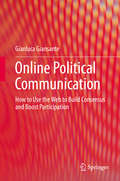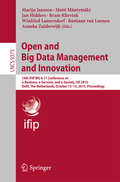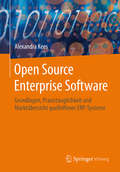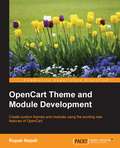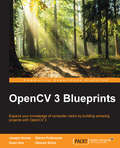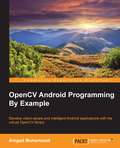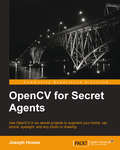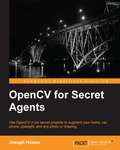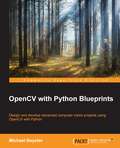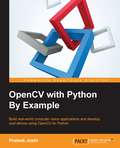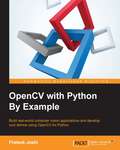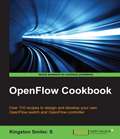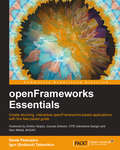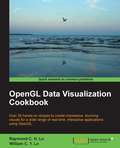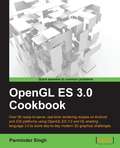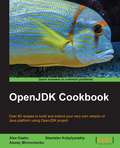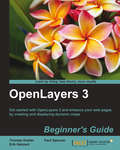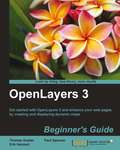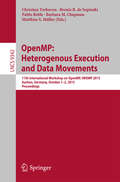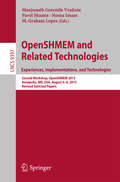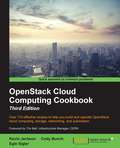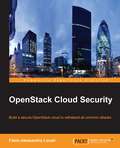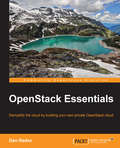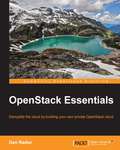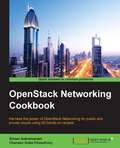- Table View
- List View
Online Political Communication
by Gianluca GiansanteThis book provides research findings and practical information on online communication strategies in politics. Based on communication research and real-world political-campaign experience, the author examines how to use the Web and social media to create public visibility, build trust and consensus and boost political participation. It offers a useful guide for practitioners working in the political arena, as well as for those managing communication projects in institutions or companies.
Open and Big Data Management and Innovation
by Anneke Zuiderwijk Bastiaan Van Loenen Winfried Lamersdorf Bram Klievink Jan Hidders Matti Mäntymäki Marijn JanssenThis book constitutes the refereed conference proceedings of the 14th IFIP WG 6. 11 Conference on e-Business, e-Services and e-Society, I3E 2015, held in Delft, The Netherlands, in October 2015. The 40 revised full papers presented together with 1 keynote panel were carefully reviewed and selected from 65 submissions. They are organized in the following topical sections: adoption; big and open data; e-business, e-services,, and e-society; and witness workshop.
Open Source Enterprise Software
by Alexandra KeesAnhand eines Marktspiegels erhalten Anwender mit dem Buch einen Überblick über die am Markt angebotene Free and Open Source (FOS) Software im Bereich der Enterprise Resource Planning Systeme (ERP-Systeme). FOS Software ist ein idealer Ansatz zur Kostenminimierung im IT-Bereich - dies gilt insbesondere für FOS ERP-Systeme. Die Durchdringung von Free and Open Source ERP-Systemen ist aber noch sehr gering. Ursache hierfür ist vor allem die Unübersichtlichkeit des Marktes. Ziel des vorliegenden Buches ist es daher, eine praxisnahe Einführung in FOS Unternehmenssoftware zu geben und einen Marktspiegel anzubieten, der als Grundlage für die Softwareauswahl von FOS ERP-Systeme genutzt werden kann.
OpenCart Theme and Module Development
by Rupak NepaliThis book is aimed at developers and designers who want to start developing their own themes and extensions and for those who want to know about the code workflow of the OpenCart theme and modules.
OpenCV 3 Blueprints
by Utkarsh Sinha Quan Hua Steven Puttemans Joseph HowseExpand your knowledge of computer vision by building amazing projects with OpenCV 3About This BookBuild computer vision projects to capture high-quality image data, detect and track objects, process the actions of humans or animals, and much moreDiscover practical and interesting innovations in computer vision while building atop a mature open-source library, OpenCV 3Familiarize yourself with multiple approaches and theories wherever critical decisions need to be madeWho This Book Is ForThis book is ideal for you if you aspire to build computer vision systems that are smarter, faster, more complex, and more practical than the competition. This is an advanced book intended for those who already have some experience in setting up an OpenCV development environment and building applications with OpenCV. You should be comfortable with computer vision concepts, object-oriented programming, graphics programming, IDEs, and the command line.What You Will LearnSelect and configure camera systems to see invisible light, fast motion, and distant objectsBuild a "camera trap", as used by nature photographers, and process photos to create beautiful effectsDevelop a facial expression recognition system with various feature extraction techniques and machine learning methodsBuild a panorama Android application using the OpenCV stitching module in C++ with NDK supportOptimize your object detection model, make it rotation invariant, and apply scene-specific constraints to make it faster and more robustCreate a person identification and registration system based on biometric properties of that person, such as their fingerprint, iris, and faceFuse data from videos and gyroscopes to stabilize videos shot from your mobile phone and create hyperlapse style videosIn DetailComputer vision is becoming accessible to a large audience of software developers who can leverage mature libraries such as OpenCV. However, as they move beyond their first experiments in computer vision, developers may struggle to ensure that their solutions are sufficiently well optimized, well trained, robust, and adaptive in real-world conditions. With sufficient knowledge of OpenCV, these developers will have enough confidence to go about creating projects in the field of computer vision.This book will help you tackle increasingly challenging computer vision problems that you may face in your careers. It makes use of OpenCV 3 to work around some interesting projects. Inside these pages, you will find practical and innovative approaches that are battle-tested in the authors' industry experience and research. Each chapter covers the theory and practice of multiple complementary approaches so that you will be able to choose wisely in your future projects. You will also gain insights into the architecture and algorithms that underpin OpenCV's functionality.We begin by taking a critical look at inputs in order to decide which kinds of light, cameras, lenses, and image formats are best suited to a given purpose. We proceed to consider the finer aspects of computational photography as we build an automated camera to assist nature photographers. You will gain a deep understanding of some of the most widely applicable and reliable techniques in object detection, feature selection, tracking, and even biometric recognition. We will also build Android projects in which we explore the complexities of camera motion: first in panoramic image stitching and then in video stabilization.By the end of the book, you will have a much richer understanding of imaging, motion, machine learning, and the architecture of computer vision libraries and applications!Style and approachThis book covers a combination of theory and practice. We examine blueprints for specific projects and discuss the principles behind these blueprints, in detail.
OpenCV Android Programming By Example
by Amgad MuhammadDevelop vision-aware and intelligent Android applications with the robust OpenCV libraryAbout This BookThis is the most up-to-date book on OpenCV Android programming on the market at the moment. There is no direct competition for our title.Based on a technology that is increasing in popularity, proven by activity in forums related to this topic.This book uniquely covers applications such as the Panoramic viewer and Automatic Selfie, among others.Who This Book Is ForIf you are an Android developer and want to know how to implement vision-aware applications using OpenCV, then this book is definitely for you.It would be very helpful if you understand the basics of image processing and computer vision, but no prior experience is requiredWhat You Will LearnIdentify and install all the elements needed to start building vision-aware Android applicationsExplore image representation, colored and gray scaleRecognize and apply convolution operations and filtering to deal with noisy dataUse different shape analysis techniquesExtract and identify interest points in an imageUnderstand and perform object detectionRun native computer vision algorithms and gain performance boostsIn DetailStarting from the basics of computer vision and OpenCV, we'll take you all the way to creating exciting applications. You will discover that, though computer vision is a challenging subject, the ideas and algorithms used are simple and intuitive, and you will appreciate the abstraction layer that OpenCV uses to do the heavy lifting for you. Packed with many examples, the book will help you understand the main data structures used within OpenCV, and how you can use them to gain performance boosts. Next we will discuss and use several image processing algorithms such as histogram equalization, filters, and color space conversion. You then will learn about image gradients and how they are used in many shape analysis techniques such as edge detection, Hough Line Transform, and Hough Circle Transform. In addition to using shape analysis to find things in images, you will learn how to describe objects in images in a more robust way using different feature detectors and descriptors.By the end of this book, you will be able to make intelligent decisions using the famous Adaboost learning algorithm.Style and approachAn easy-to-follow tutorial packed with hands-on examples. Each topic is explained and placed in context, and the book supplies full details of the concepts used for added proficiency.
OpenCV for Secret Agents
by Joseph HowseThis book is for programmers who want to expand their skills by building fun, smart, and useful systems with OpenCV. The projects are ideal in helping you to think creatively about the uses of computer vision, natural user interfaces, and ubiquitous computers (in your home, car, and hand).
OpenCV for Secret Agents
by Joseph Howse<P><P>Use OpenCV in six secret projects to augment your home, car, phone, eyesight, and any photo or drawing <P><P>About This Book <P><P>Build OpenCV apps for the desktop, the Raspberry Pi, Android, and the Unity game engine <P><P>Learn real-time techniques that can be used to classify images, detecting and recognizing any person or animal, and studying motion and distance with superhuman precision <P><P>Design hands-free interfaces that are practical in home automation, in cars, and in discrete surveillance <P><P>Who This Book Is For <P><P>This book is for programmers who want to expand their skills by building fun, smart, and useful systems with OpenCV. The projects are ideal in helping you to think creatively about the uses of computer vision, natural user interfaces, and ubiquitous computers (in your home, car, and hand). <P><P>What You Will Learn <P><P>Install OpenCV, a Python development environment, and an Android development environment on Windows, Mac, or Linux and install a Unity development environment on Windows or Mac <P><P>Get to grips with motion detection and gesture recognition as a means of controlling a guessing game on a smartphone <P><P>Detect car headlights, estimate distances to them, and provide feedback to the driver <P><P>Spot and recognize human faces and cat faces as a means of controlling an alarm <P><P>Amplify motion in real-time video so that a person's heartbeat and breathing become clearly visible <P><P>Draw a ball-in-a-maze puzzle on paper and see it come to life as a physics simulation on a smartphone <P><P>Integrate OpenCV with other libraries, as well as popular frameworks for GUI apps and games <P><P>In Detail <P><P>OpenCV is a grand collection of image processing functions and computer vision algorithms. It is open source, it supports many programming languages and platforms, and it is fast enough for many real-time applications. What a lot of gadgets we can build with such a handy library! <P><P>Taking inspiration from the world of James Bond, this book adds a spark of adventure and computer vision to your daily routine. Protect your home and car with intelligent camera systems that analyze people, cats, and obstacles. Let your search engine praise or criticize the images that it finds. Hear a voice from your phone that responds to your body language. Attune yourself to another person's rhythm by glancing at a display that magnifies a heartbeat or a breath. Learn OpenCV and see your world as never before.
OpenCV with Python Blueprints
by Michael BeyelerDesign and develop advanced computer vision projects using OpenCV with PythonAbout This BookProgram advanced computer vision applications in Python using different features of the OpenCV libraryPractical end-to-end project covering an important computer vision problemAll projects in the book include a step-by-step guide to create computer vision applicationsWho This Book Is ForThis book is for intermediate users of OpenCV who aim to master their skills by developing advanced practical applications. Readers are expected to be familiar with OpenCV's concepts and Python libraries. Basic knowledge of Python programming is expected and assumed.What You Will LearnGenerate real-time visual effects using different filters and image manipulation techniques such as dodging and burningRecognize hand gestures in real time and perform hand-shape analysis based on the output of a Microsoft Kinect sensorLearn feature extraction and feature matching for tracking arbitrary objects of interestReconstruct a 3D real-world scene from 2D camera motion and common camera reprojection techniquesTrack visually salient objects by searching for and focusing on important regions of an imageDetect faces using a cascade classifier and recognize emotional expressions in human faces using multi-layer peceptrons (MLPs)Recognize street signs using a multi-class adaptation of support vector machines (SVMs)Strengthen your OpenCV2 skills and learn how to use new OpenCV3 featuresIn DetailOpenCV is a native cross platform C++ Library for computer vision, machine learning, and image processing. It is increasingly being adopted in Python for development. OpenCV has C++/C, Python, and Java interfaces with support for Windows, Linux, Mac, iOS, and Android. Developers using OpenCV build applications to process visual data; this can include live streaming data from a device like a camera, such as photographs or videos. OpenCV offers extensive libraries with over 500 functionsThis book demonstrates how to develop a series of intermediate to advanced projects using OpenCV and Python, rather than teaching the core concepts of OpenCV in theoretical lessons. Instead, the working projects developed in this book teach the reader how to apply their theoretical knowledge to topics such as image manipulation, augmented reality, object tracking, 3D scene reconstruction, statistical learning, and object categorization.By the end of this book, readers will be OpenCV experts whose newly gained experience allows them to develop their own advanced computer vision applications.Style and approachThis book covers independent hands-on projects that teach important computer vision concepts like image processing and machine learning for OpenCV with multiple examples.
OpenCV with Python By Example
by Prateek JoshiBuild real-world computer vision applications and develop cool demos using OpenCV for Python <P><P> About This Book<P> * Learn how to apply complex visual effects to images using geometric transformations and image filters<P> * Extract features from an image and use them to develop advanced applications<P> * Build algorithms to help you understand the image content and perform visual searches<P> Who This Book Is For<P> This book is intended for Python developers who are new to OpenCV and want to develop computer vision applications with OpenCV-Python. This book is also useful for generic software developers who want to deploy computer vision applications on the cloud. It would be helpful to have some familiarity with basic mathematical concepts such as vectors, matrices, and so on. <P> What You Will Learn <P> * Apply geometric transformations to images, perform image filtering, and convert an image into a cartoon-like image<P> * Detect and track various body parts such as the face, nose, eyes, ears, and mouth<P> * Stitch multiple images of a scene together to create a panoramic image<P> * Make an object disappear from an image * Identify different shapes, segment an image, and track an object in a live video<P> * Recognize an object in an image and build a visual search engine<P> * Reconstruct a 3D map from images<P> * Build an augmented reality application In Detail Computer vision is found everywhere in modern technology. OpenCV for Python enables us to run computer vision algorithms in real time. With the advent of powerful machines, we are getting more processing power to work with. Using this technology, we can seamlessly integrate our computer vision applications into the cloud. Web developers can develop complex applications without having to reinvent the wheel. This book will walk you through all the building blocks needed to build amazing computer vision applications with ease. We start off with applying geometric transformations to images. We then discuss affine and projective transformations and see how we can use them to apply cool geometric effects to photos. We will then cover techniques used for object recognition, 3D reconstruction, stereo imaging, and other computer vision applications. This book will also provide clear examples written in Python to build OpenCV applications. The book starts off with simple beginner's level tasks such as basic processing and handling images, image mapping, and detecting images. It also covers popular OpenCV libraries with the help of examples. The book is a practical tutorial that covers various examples at different levels, teaching you about the different functions of OpenCV and their actual implementation. Style and approach This is a conversational-style book filled with hands-on examples that are really easy to understand. Each topic is explained very clearly and is followed by a programmatic implementation so that the concept is solidified. Each topic contributes to something bigger in the following chapters, which helps you understand how to piece things together to build something big and complex.
OpenCV with Python By Example
by Prateek Joshi<P><P>Build real-world computer vision applications and develop cool demos using OpenCV for Python <P><P>About This Book <P><P>Learn how to apply complex visual effects to images using geometric transformations and image filters <P><P>Extract features from an image and use them to develop advanced applications <P><P>Build algorithms to help you understand the image content and perform visual searches <P><P>Who This Book Is For <P><P>This book is intended for Python developers who are new to OpenCV and want to develop computer vision applications with OpenCV-Python. This book is also useful for generic software developers who want to deploy computer vision applications on the cloud. It would be helpful to have some familiarity with basic mathematical concepts such as vectors, matrices, and so on. <P><P>What You Will Learn <P><P>Apply geometric transformations to images, perform image filtering, and convert an image into a cartoon-like image <P><P>Detect and track various body parts such as the face, nose, eyes, ears, and mouth <P><P>Stitch multiple images of a scene together to create a panoramic image <P><P>Make an object disappear from an image <P><P>Identify different shapes, segment an image, and track an object in a live video <P><P>Recognize an object in an image and build a visual search engine <P><P>Reconstruct a 3D map from images <P><P>Build an augmented reality application <P><P>In Detail <P><P>Computer vision is found everywhere in modern technology. OpenCV for Python enables us to run computer vision algorithms in real time. With the advent of powerful machines, we are getting more processing power to work with. Using this technology, we can seamlessly integrate our computer vision applications into the cloud. Web developers can develop complex applications without having to reinvent the wheel. <P><P>This book will walk you through all the building blocks needed to build amazing computer vision applications with ease. We start off with applying geometric transformations to images. We then discuss affine and projective transformations and see how we can use them to apply cool geometric effects to photos. We will then cover techniques used for object recognition, 3D reconstruction, stereo imaging, and other computer vision applications. <P><P>This book will also provide clear examples written in Python to build OpenCV applications. The book starts off with simple beginner's level tasks such as basic processing and handling images, image mapping, and detecting images. It also covers popular OpenCV libraries with the help of examples. <P><P>The book is a practical tutorial that covers various examples at different levels, teaching you about the different functions of OpenCV nd their actual implementation.
OpenFlow Cookbook
by Kingston Smiler. SThis book is intended for network protocol developers, SDN controller application developers, and academics who would like to understand and develop their own OpenFlow switch or OpenFlow controller in any programming language. With basic understanding of OpenFlow and its components, you will be able to follow the recipes in this book.
openFrameworks Essentials
by Igor Sodazot Tatarnikov Denis PerevalovIf you are a programmer, visual artist, or designer with experience in creative coding, and want to use openFrameworks to create fun, stunning, and interactive applications, this is the book for you. Basic knowledge of programming languages, such as C++, Java, Python, or JavaScript, will be enough to proceed with the book.
OpenGL Data Visualization Cookbook
by William C. Y. Lo Raymond C. H. LoOver 40 hands-on recipes to create impressive, stunning visuals for a wide range of real-time, interactive applications using OpenGL About This Book * Get acquainted with a set of fundamental OpenGL primitives and concepts that enable users to create stunning visuals of arbitrarily complex 2D and 3D datasets for many common applications * Explore interactive, real-time visualization of large 2D and 3D datasets or models, including the use of more advanced techniques such as stereoscopic 3D rendering. * Create stunning visuals on the latest platforms including mobile phones and state-of-the-art wearable computing devices Who This Book Is For This book is aimed at anyone interested in creating impressive data visualization tools using modern graphics hardware. Whether you are a developer, engineer, or scientist, if you are interested in exploring the power of OpenGL for data visualization, this book is for you. While familiarity with C/C++ is recommended, no previous experience with OpenGL is assumed. What You Will Learn * Install, compile, and integrate the OpenGL pipeline into your own project * Create interactive applications using GLFW and handle user inputs with callback functions * Use OpenGL primitives and features in the OpenGL Shading Language (GLSL) * Render complex 3D volumetric data with techniques such as data slicers and multiple viewpoint projection * Implement a hardware-accelerated data visualizer, heat map generator, point cloud rendering, perspective rendering, and alpha blending * Process images or video sources with texture mapping and custom fragment shader programs for image resizing and wrapping * Develop video see-through augmented reality applications with OpenGL * Visualize 3D models using meshes and surfaces with dynamic lighting In Detail OpenGL is a great multi-platform, cross-language, and hardware-accelerated graphics interface for visualizing large 2D and 3D datasets. Data visualization has become increasingly challenging using conventional approaches as datasets become larger and larger, especially with the Big Data evolution. From a mobile device to a sophisticated high-performance computing cluster, OpenGL libraries provide developers with an easy-to-use interface to create stunning visuals in 3D in real time for a wide range of interactive applications. This book provides easy-to-follow, hands-on tutorials to create appealing OpenGL-based visualization tools with minimal development time. We will first illustrate how to quickly set up the development environment in Windows, Mac, and Linux. Next, we will demonstrate how to visualize data for a wide range of applications using OpenGL, starting from simple 2D datasets to increasingly complex 3D datasets with more advanced techniques. Each chapter addresses different visualization problems encountered in real life and introduces the relevant OpenGL features and libraries in a modular fashion. By the end of this book, you will be equipped with the essential skills to develop a wide range of impressive OpenGL-based applications for your unique data visualization needs, on platforms ranging from conventional computers to the latest mobile/wearable devices. Style and approach This is an easy-to-follow, comprehensive Cookbook showing readers how to create an application with real-time, interactive data visualization in stereoscopic 3D. Each topic is explained in a step-by-step format. A range of hot topics is included, including data visualization on mobile and wearable platforms."
OpenGL ES 3.0 Cookbook
by Parminder SinghIf you are new to OpenGL ES or have some experience in 3D graphics, then this book will be extremely helpful in raising your expertise level from a novice to professional. The book implements more than 90 recipes to solve everyday challenges, helping you transition from a beginner to a professional.
OpenJDK Cookbook
by Stanislav Kobylyanskiy Alex KaskoIf you are an experienced Java developer using Java 7 platform and want to get your grips on OpenJDK for Java development, this is the book for you. JDK users who wish to migrate to OpenJDK will find this book very useful.
OpenLayers 3: Beginner's Guide
by Thomas Gratier Paul SpencerWhether you are a hobbyist or a professional web developer, if you wish to use maps on your website, then this book is for you. A basic understanding of JavaScript will be helpful, but is not necessary. If you've never worked with maps before, this book will introduce you to some common mapping topics and will guide you through the OpenLayers library. Experienced developers can also use this book as a reference to OpenLayers 3 components and to further enhance their knowledge.
OpenLayers 3 Beginner's Guide
by Thomas Gratier<P><P>About This Book <P><P>Create and display maps online with the latest HTML5 features available, using the OpenLayers 3 library <P><P>Learn how to interact with the map and learn best practices to improve the loading time for a map <P><P>A practical beginner's guide, which also serves as a quick reference with useful screenshots and detailed code explanations <P><P>Who This Book Is For <P><P>Whether you are a hobbyist or a professional web developer, if you wish to use maps on your website, then this book is for you. A basic understanding of JavaScript will be helpful, but is not necessary. If you've never worked with maps before, this book will introduce you to some common mapping topics and will guide you through the OpenLayers library. Experienced developers can also use this book as a reference to OpenLayers 3 components and to further enhance their knowledge. <P><P>What You Will Learn <P><P>Build a complete, real-world OpenLayers application optimized for production use <P><P>Work with different raster data sources to create a base map <P><P>Overlay vector data sources and work with vector features directly <P><P>Customize the appearance of vector layers <P><P>Understand the concept of map projections and how to use them <P><P>Manage and work with interactions such as click and touch <P><P>Work with controls to enhance the user experience <P><P>Target mobile platforms and explore challenges presented by mobile development <P><P>In Detail <P><P>This book is a practical, hands-on guide that provides you with all the information you need to get started with mapping using the OpenLayers 3 library. <P><P>The book starts off by showing you how to create a simple map. Through the course of the book, we will review each component needed to make a map in OpenLayers 3, and you will end up with a full-fledged web map application. You will learn the key role of each OpenLayers 3 component in making a map, and important mapping principles such as projections and layers. You will create your own data files and connect to backend servers for mapping. A key part of this book will also be dedicated to building a mapping application for mobile devices and its specific components.
OpenMP: Heterogenous Execution and Data Movements
by Matthias S. Müller Barbara M. Chapman Pablo Reble Bronis R. de Supinski Christian TerbovenThis book constitutes the refereed proceedings of the 11th International Workshop on OpenMP, held in Aachen, Germany, in October 2015. The 19 technical full papers presented were carefully reviewed and selected from 22 submissions. The papers are organized in topical sections on applications, accelerator applications, tools, extensions, compiler and runtime, and energy.
OpenSHMEM and Related Technologies. Experiences, Implementations, and Technologies
by Manjunath Gorentla Venkata Pavel Shamis Neena Imam M. Graham LopezThis book constitutes the proceedings of the SecondOpenSHMEM Workshop, held in Annapolis, MD, USA, in August 2015. The 12 technical papers and one short position paperspresented in this book were carefully reviewed and selected from 17submissions. The topics of the workshop included extensions to the OpenSHMEMAPI, implementation of the API for current and emerging architectures, tools todebug and profile OpenSHMEM programs, experience porting applications to theOpenSHMEM programming model, and changes to the OpenSHMEM specification toaddress the needs of programming exascale systems.
OpenStack Cloud Computing Cookbook - Third Edition
by Cody Bunch Kevin JacksonThis book is aimed at cloud system engineers, system administrators, and technical architects who are moving from a virtualized environment to cloud environments. This book assumes that you are familiar with cloud computing platforms, and have knowledge of virtualization, networking, and managing Linux environments.
OpenStack Cloud Security
by Fabio Alessandro LocatiIf you are an OpenStack administrator or developer, or wish to build solutions to protect your OpenStack environment, then this book is for you. Experience of Linux administration and familiarity with different OpenStack components is assumed.
OpenStack Essentials
by Dan RadezIf you need to get started with OpenStack or want to learn more, then this book is your perfect companion. If you're comfortable with the Linux command line, you'll gain confidence in using OpenStack.
OpenStack Essentials
by Dan Radez<P><P>Demystify the cloud by building your own private OpenStack cloud <P><P>About This Book <P><P>Set up a powerful cloud platform using OpenStack <P><P>Learn about the components of OpenStack and how they interact with each other <P><P>Follow a step-by-step process that exposes the inner details of an OpenStack cluster <P><P>Who This Book Is For <P><P>If you need to get started with OpenStack or want to learn more, then this book is your perfect companion. If you're comfortable with the Linux command line, you'll gain confidence in using OpenStack. <P><P>What You Will Learn <P><P>Install OpenStack using the Packstack installation tool <P><P>Create users, cloud images, and virtual networks to launch cloud instances <P><P>Explore horizontal scaling to support the load that a cloud platform is expected to handle <P><P>Set up monitoring to keep track of the health of an OpenStack cloud <P><P>Troubleshoot issues with an OpenStack cluster <P><P>Build storage and access it from your running cloud instances <P><P>Orchestrate a multi-instance deployment to build a complex set of virtual infrastructure to run an application in the cloud <P><P>Keep track of resources being consumed within an OpenStack cloud through metering <P><P>In Detail <P><P>An OpenStack cloud is a complex jungle of components that can speed up managing a virtualization platform. Applications that are built for this platform are resilient to failure and convenient to scale. OpenStack allows administrators and developers to consolidate and control pools of compute, networking, and storage resources, with a centralized dashboard and administration panel to enable the large-scale development of cloud services. <P><P>Begin by exploring and unravelling the internal architecture of the OpenStack cloud components. After installing the RDO distribution, you will be guided through each component via hands-on exercises, learning more about monitoring and troubleshooting the cluster. By the end of the book, you'll have the confidence to install, configure, and administer an OpenStack cloud. <P><P>This is a practical and comprehensive tutorial on sorting out the complexity of an OpenStack cloud.
OpenStack Networking Cookbook
by Chandan Dutta Chowdhury Sriram SubramanianThis book is aimed at network and system administrators who want to deploy and manage OpenStack-based cloud and IT infrastructure. If you have basic knowledge of OpenStack and virtualization, this book will help you leverage the rich functionality of OpenStack Networking in your cloud deployments.
